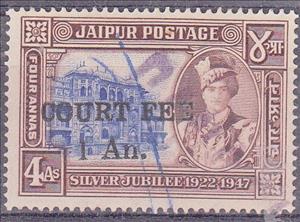Stamp: Gate of Amber Fort (Jaipur 1948)
Gate of Amber Fort (Jaipur 1948)
01 January (Jaipur ) within release Court Fee goes into circulation Stamp Gate of Amber Fort face value 4 Indian anna
| Stamp Gate of Amber Fort in catalogues | |
|---|---|
| Colnect codes: | Col: IN-JA CF1948-03 |
Stamp is square format.
Also in the issue Court Fee:
- Stamp - Chariot of the Sun face value 8;
- Stamp - Gate of Amber Fort face value 4;
|
Data entry completed
50%
|
|
|---|---|
| Stamp Gate of Amber Fort in digits | |
| Country: | Jaipur |
| Date: | 1948-01-01 |
| Print: | Offset lithography |
| Emission: | Revenue |
| Format: | Stamp |
| Face Value: | 4 Indian anna |
Stamp Gate of Amber Fort it reflects the thematic directions:
A building or edifice is a structure with a roof and walls standing more or less permanently in one place, such as a house or factory. Buildings come in a variety of sizes, shapes and functions, and have been adapted throughout history for a wide number of factors, from building materials available, to weather conditions, to land prices, ground conditions, specific uses and aesthetic reasons. Buildings serve several needs of society – primarily as shelter from weather, security, living space, privacy, to store belongings, and to comfortably live and work. A building as a shelter represents a physical division of the human habitat (a place of comfort and safety) and the outside (a place that at times may be harsh and harmful).
King is the title given to a male monarch in a variety of contexts. The female equivalent is queen regnant (while the title of queen on its own usually refers to the consort of a king). In the context of prehistory, antiquity and contemporary indigenous peoples, the title may refer to tribal kingship. Germanic kingship is cognate with Indo-European traditions of tribal rulership (c.f. Indic rājan, Gothic reiks, and Old Irish rí, etc.) In the context of classical antiquity, king may translate Latin rex or either Greek archon or basileus. In classical European feudalism, the title of king as the ruler of a kingdom is understood as the highest rank in the feudal order, potentially subject, at least nominally, only to an emperor (harking back to the client kings of the Roman Empire). In a modern context, the title may refer to the ruler of one of a number of modern monarchies (either absolute or constitutional). The title of king is used alongside other titles for monarchs, in the West prince, emperor, archduke, duke or grand duke, in the Middle East sultan or emir; etc. Kings, like other royalty, tend to wear purple because purple was an expensive color to wear in the past.


